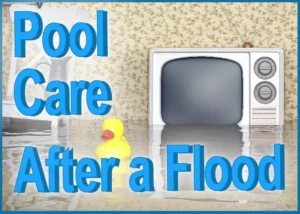61
Pool Care after a Flood
 We have just received substantial rainfall, especially in the northern part of Denton County.
We have just received substantial rainfall, especially in the northern part of Denton County.
I am thankful for the rain, as it will help fill area lakes, but this much rain at one time can cause problems—even for swimming pools. Following are some tips to help with some issues that you might be having due to this heavy rain:
Pool is overflowing—
If your pool is overflowing, it is probably a good idea to drain some water. Depending on your pool equipment, there are several different ways that you can drain water from your pool:
Multiport valve (also called dial valve)
- Turn pump off.
- Set out backwash hose (if applicable).
- Turn valve to waste position.
- Turn pump on until water level reaches desired level.
- Turn pump off.
- Turn valve to filter position.
- Turn pump on.
Push/pull valve (also called slide valve)
- Turn pump off.
- Set out backwash hose (if applicable).
- Turn valve to backwash position.
- Turn pump on until water level reaches desired level.
- Turn pump off.
- Turn valve to filter position.
- Turn pump on.
- If filter is a DE filter, recharge filter with DE.
Cartridge filters
These types of filters do not have backwash valves, therefore each system is different as to whether you can drain water from the pool or not. Oftentimes there is a hose bib plumbed into the line which allows you to drain water from the pool.
If you are unsure how to drain water from your pool, give us a call and we will do our best to help you.
Drainage problems—When it rains as much as it has, even pools that typically do not have drainage problems are having problems. If poor drainage is an issue which causes rain water draining into the pool, corrections can sometimes be made. Many pool elevations are dictated by the elevation of the house, which are many times too low to begin with. But oftentimes drainage can be dealt with by the use of drainage systems and/or retaining walls. In addition, installing gutters on the house usually helps with pool-area drainage.
Debris in the pool—This can be very frustrating, as a perfectly clean pool can become filthy in just a few minutes. It is helpful to run the pump and the automatic cleaner during a storm, which helps in dealing with debris that blows into the pool during a storm. After the storm, clean the skimmer baskets, skim debris off of the surface, and vacuum the pool if necessary. It is often necessary to operate the pump and automatic cleaner for an extended period of time after the storm—this helps filter the water and also cleans the debris off of the floor of the pool.
Water chemistry—This is typically the biggest issue when dealing with a rainstorm, as the water chemistry is usually adversely affected. It should be no surprise that water chemistry is affected—since anything and everything that is added to the pool affects it—especially rain and debris. Immediately after the rain ends, test the water—and be especially sure that the pH is in the proper range. Then, superchlorinate the pool water.
To summarize, do the following after a heavy rain:
- Drain water from the pool.
- Determine if drainage problems exist which can be corrected.
- Remove debris from the skimmer baskets.
- Skim debris off of the surface of the pool.
- Vacuum the pool as necessary.
- Check water chemistry and be sure that the pH is in the proper range.
- Superchlorinate according to label directions.
- Consider operating the pump and automatic cleaner for an extended period of time to help clean up the pool. This sometimes creates a dirty filter—therefore clean/backwash the filter as needed.
- Check the water chemistry the day after the storm and adjust as necessary.
- If problems still exist, call Gohlke Pools at (940) 387-7521 or bring a sample of your water into our retail store for a complete analysis.




